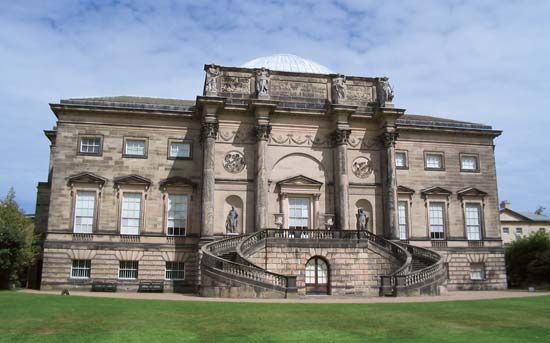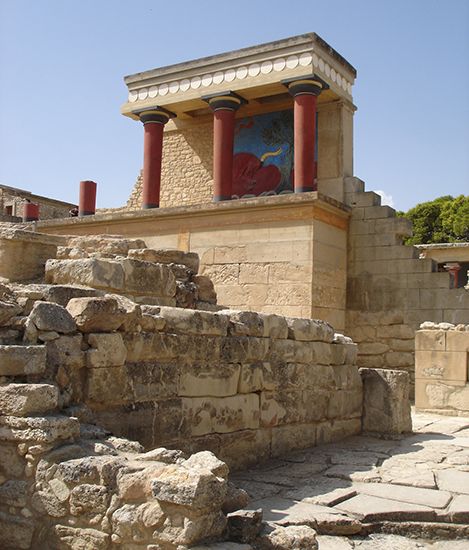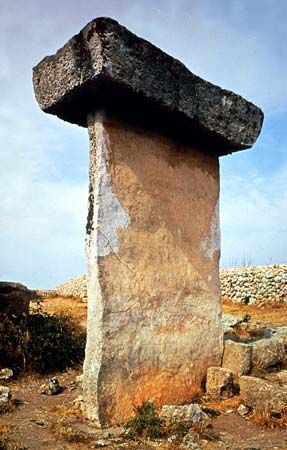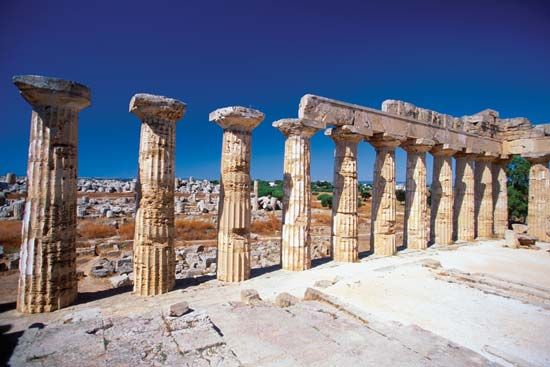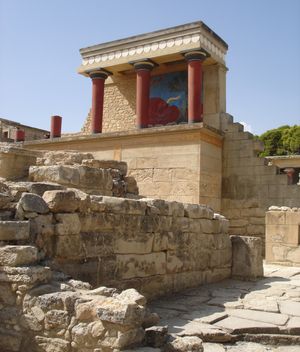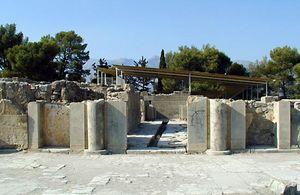Western architecture
Western architecture, history of Western architecture from prehistoric Mediterranean cultures to the 21st century.
The history of Western architecture is marked by a series of new solutions to structural problems. During the period from the beginning of civilization through ancient Greek culture, construction methods progressed from the shed roof and simple truss to the vertical posts, or columns, supporting horizontal beams, or lintels (see post-and-lintel system). Greek architecture also formalized many structural and decorative elements into three Classical orders—Ionic, Doric, and Corinthian—which, to a greater or lesser extent, have influenced architecture since that time. The Romans exploited the arch, vault, and dome and made broader use of the load-bearing masonry wall. In the late medieval period, the pointed arch, ribbing, and pier systems gradually emerged. At this point many of the problems of brick and stone masonry construction had been solved, and, beyond decorative advances, little innovation was achieved until the Industrial Revolution. Not until the 19th century, with the advent of cast-iron and steel construction, did a new architectural age dawn and higher, broader, and lighter buildings become possible. With the advances of 20th-century technology, new structural methods such as cantilevering received more extensive use. By the turn of the 21st century, computers had further enhanced architects’ ability to conceptualize and create new forms.
For the purposes of this article, “Western architecture” signifies architecture in Europe as well as in regions that share a European cultural tradition. For example, this article discusses early architectural traditions in areas such as Egypt, Syria, Asia Minor, North Africa, and Jerusalem, which, beginning in the Hellenistic and Roman periods and continuing through the period of the Byzantine Empire, were closely tied to architectural developments in Europe. By the late 15th century, European architectural styles spread to the Americas. North American architecture is also treated in this article; for treatment of Latin American architecture, see Latin American architecture. (Native American architectural traditions were generally unaffected by European influence; for that history, see Native American art.)
The technical and theoretical aspects of the medium are examined elsewhere; see architecture.
European Metal Age cultures
Aegean and eastern Mediterranean
The islands of the eastern Mediterranean and the Aegean Sea form a natural link between the landmasses of the Middle East and Europe. A westward expansion from the civilizations of western Asia and Egypt began about 3000 bce and led to settlements in Crete, the Cyclades, and mainland Greece. The fundamental difference between these and the earlier, Neolithic cultures is that stone tools and weapons were replaced by those made of copper and, later, bronze. The Chalcolithic (Copper-Stone) Age, lasting in the Aegean area from the early 3rd millennium bce to the beginning of the 2nd, is usually considered a part of the greater Bronze Age, which was superseded by the Iron Age from about 1200 bce.

The hallmark of the Aegean civilizations was the facility with which Asiatic motifs and techniques were adapted to form original local styles. In architecture, by far the most important achievements were those of the civilizations of Minoan Crete and Mycenaean Greece.
Minoan Crete
The great maritime civilization of Crete crystallized around palaces such as those at Knossos, Phaestus, Ayía Triáda, Mallia, and Tylissos. The immensely important Palace of Minos at Knossos, excavated and reconstructed early in the 20th century by Sir Arthur Evans, offers evidence of unbroken architectural and artistic development from Neolithic beginnings, culminating in a brilliant display of building activity during the third phase of the Middle Minoan period (1700–1580 bce) and continuing until the invasion of the Achaeans in the 12th century. The palace, however, is essentially a structure of the late two Middle Minoan periods (1800–1580 bce). It no doubt rivaled Middle Eastern and Egyptian palaces in monumentality. Following the example of such structures, the Palace of Minos is a quadrangular complex of rooms and corridors grouped around a great central court, roughly 175 × 100 feet (50 × 30 metres). At the northern end, toward the sea, a grand portico of 12 pilasters would have given access to the central court. At this end, also, is situated the grand theatrical area, a rectangular open-air theatre that was perhaps used for ritual performances. The east wing of the palace is divided into two parts by a long corridor running on an east–west axis; originally it rose four or five stories above the slope of the valley. The southeast portion of the palace contains domestic apartments, elaborately supplied with plumbing and flushing facilities, as well as a sanctuary. A wide stairway led to an upper story, which no longer exists. The northeast portion of the palace is occupied by offices and storerooms. The west portion is again divided by a main corridor, more than 200 feet (60 metres) long, running north and south. Behind this corridor, along the western side, was discovered a series of long narrow storerooms containing great numbers of pithoi, or human-size storage vessels for oil. On the other side of the corridor, facing toward the central court, are the rooms of state, including the throne room with its unique gypsum throne and world-famous griffin frescoes. Brilliantly hued frescoes played an important part in both the interior and the exterior decoration of the palace. Light was supplied from above by an ingenious system of light wells, and several colonnaded porticoes provided ventilation during the hot Cretan summers.
The development of the other Minoan palaces (Phaestus, Mallia, Ayía Triáda, Tylissos) roughly parallels that of Knossos. Each is notable, and Phaestus is particularly fascinating, due to extensive Italian excavations. Maritime hegemony enabled the Cretan sea kings to build these palaces in low and unprotected places; consequently there is a conspicuous absence of fortification walls, as contrasted to the great walls of Mesopotamian palaces. Since Cretan worship seems to have been conducted largely in the open air, there are no real temples as in the Middle East. Yet, the disposition of the various parts of the palace around the central court and the avoidance of outside windows as much as possible are characteristics that seem to indicate an early contact with the Middle East. A taste for long, straight palace corridors, as well as a highly developed water-supply system, may also have been inherited from older civilizations to the east. The column made its first European appearance in the Cretan palace, where it is often employed individually to divide an entranceway.
The development of funerary architecture in Crete proceeds from the old chamber ossuaries of the Early Minoan period (2750–2000 bce) to the developed tholoi, or beehive tombs, of the Mesara plain and the elaborate temple-tombs of Knossos that appeared at the end of the Middle Minoan period.
On the crest of Minoan prosperity came a great crash. An invasion from the mainland about 1400 bce destroyed the palaces and resulted in the removal of power to Mycenaean Greece. Architectural remains in Crete of structures that are pre-Greek in design and yet were built subsequent to this catastrophe are very rare. Several country shrines belong to this post-destruction period, and at Prinias a unique temple building may date from as late as 700 bce. The doorway of this temple has low reliefs on its architectural members. The opening above the lintel is flanked by seated figures, while the lintel itself is carved on its underside with figures of a goddess and of animals. The column that seems to have stood in the middle of this doorway, as at the Palace of Minos, indicates that the Minoan tradition was not entirely extinct.

